History of Baseball Video Games #14 - TG-16 World Class Baseball
By jbn566 1 Comments
This is a series of blogs based on my own personal game collection. I will attempt to go through them in a chronological order according to their release date. I will also attempt to play then on their original platform using the original controllers the game was designed for. If I am unable to get the system or the game working then I will use PC emulation or another platform emulation like the Intellivision Lives! game for the gamecube
Previous entries
9. Sega Master System's Great Baseball (1987) 10. Nintendo's Bases Loaded (1987) 11. Nintendo's R.B.I Baseball (1988) 12. Nintendo's Major League Baseball (1988) 13. Sega Master System's Reggie Jackson Baseball (1988) |
World Class Baseball for TurboGrafx-16 (1989)
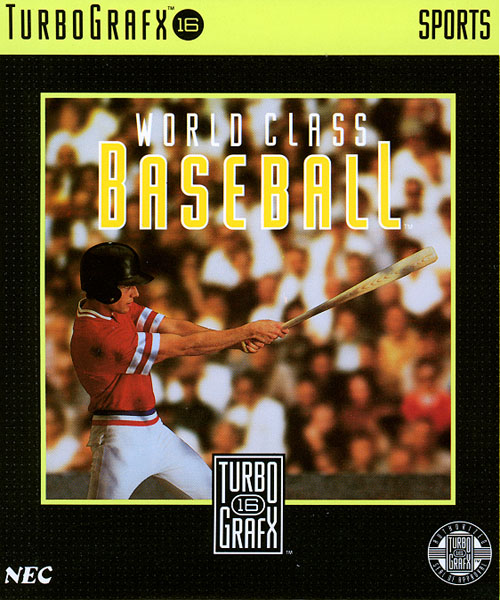
This blog is steadily marching on through history of baseball video games. We are now in the year 1989 and many new systems are now available. One of the new platforms is the short lived, TurboGrafx-16. I believe World Class Baseball for the TurboGrafx-16 is the only baseball game released in the United States. I should mention that even though 1989 is bringing us 16-bit gaming, the little system that could from the 70's, released it most advanced baseball game as well. I am referring to Pete Rose's Baseball for the Atari 2600 and 7800. Sadly I do not have a copy of the game so it is not included in this blog series at this time. Pete Rose Baseball was not really innovated in terms of baseball games go but compared to their 1978 Home Run game; it is amazing feat to still be able to produce quality games more than 10 years after its launch. It is too bad that in 1989, people traded in their Atari 2600 for a TurboGrafx-16 or Sega Genesis and Pete Rose Baseball did not do well in retail. Was the trade considered world class?
Graphics
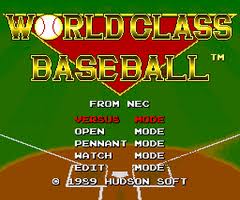
This is the first 16-bit baseball game in this blog series and from a graphics perspective; it is easy to see the importance of 16-bits compared to 8-bits. We can begin to see more textures and an increase color palette. The text is more readable as well as the baselines are very crisp and not jaggy. Regarding the text, the font has a nice thin black outline to them which make it pop up and not cause color bleeding. The B/S/O counts use different colors but oddly the arrangements of the three counts in the game are non-standard. The game lists it as S/B/O.
Field
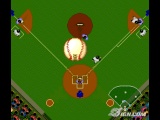
The field in the game resembles that of an astroturf field; the infield only has dirt around the bases for sliding but not along the base paths. The behind the batter view shows lawnmower lines in the field as if it was freshly mowed before the game. It is a nice graphical innovation and helps provides the gamer a sense of realism. The field contains the on deck circle, base path for first base, base coach boxes as well as base coaches. While I do like the fact they included the base coaches in the game, I found them more of a distraction than a nice graphical touch to the game. Maybe it was the camera angle or maybe because they look 100% like a base runner but I found myself throwing to a base because I thought I saw a base runner off the base only to realize it was the base coach just standing there. I think it would help the gamer if they added some separation between the coaches on the field vs the players on the field of play. I don’t find the umpires distracting because they are often wearing blue or black.
Players
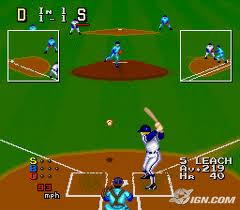
The behind the batter view has steadily gained improvements on the rendering of the players. The uniforms are now detailed, the batter has a helmet and the stirrups are very pronounced part of the uniform. The batting swing is also fluid and smooth. The catcher's straps are also well detailed. A new batter’s animation is introduced in this game. No longer do we see the batter sprite slide around in the batter’s box as we move him. The legs actually move like a human is expected to move. While the behind the batter view is detailed the overhead view sort of lacks detail. The overhead view is slightly boring and something an 8-bit platform can easily handle. During the fielding, the players all look the same and very generic. The game does not include the real MLB teams nor are players; the teams are made up so I can’t comment on how they compare to the real life players.
Scoreboard
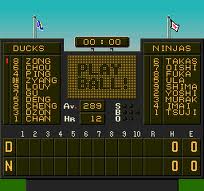
The scoreboard in this game looks very nice. The jumbotron is made up of small light bulbs that give it that pixilated look to video that you would actually see in baseball parks in the late 80’s. Scoreboards back then were just starting to get electric and video and you won’t actually see huge TV screen resolutions on scoreboards till the late 90’s. The scoreboard displays each team’s lineup and an indicator on who is up to bat as well as the current batter’s avg and homerun count. It does lack any information about the current pitcher however. The inning summary is displayed up to 10 innings as well as the game total runs, hits and errors. One thing I did notice is that inning run count was incapable of displaying double digits. I had 12 runs scored on me in the 8th inning one time and it only displayed ‘2’. FYI… there is no mercy run in this game.
Fans
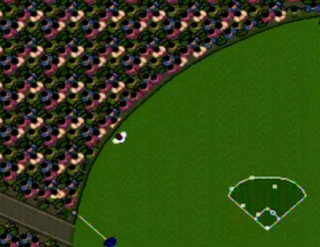
We continue to progress regarding the crowd in baseball video games. Here we see individual fans in the crowd as well as the seats they sit in. The crowd pattern for this game includes empty seats which is more realistic. All the fans have the same color hair, but different color shirts. They are all the same size as well.
Home Run Celebration
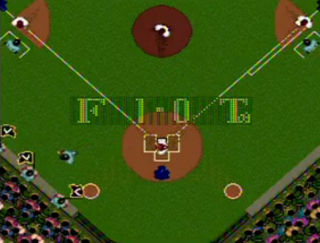
I would say only 2 bits of the 16 bits of the game was required to produce the home run celebration. The words ‘Home Run’ appear in the center of the screen as the ball lands in the stands. When the ball hits the stands however the ball didn’t disappear but rather continue to get smaller until it runs off screen, it was a weird effect that didn’t match the camera’s top down perspective. The camera stays with the crowd until the batter runs down the third base line and connects with the plate. The runner then goes back to his dugout where you see his teammates waving flags as he stands in front of them and waves his hands to the crowd. The celebration within the dugout is enjoyable to watch and hearing the home run melody is always fun to hear.
Camera/Screens
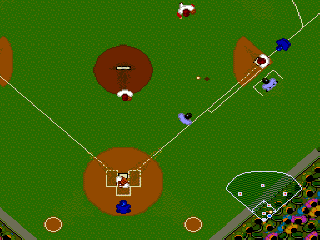
This game introduces a true top down perspective during the fielding. You only see the player’s helmet/hat and shoulders. The hands and feet pop in and out of the sides of the player while they run or throw. The catcher is rendered differently in the overhead due to the straps for his pads, nice touch. The camera switches to this top down camera during strikes out which lets us see the next batter approaching the batter’s box. Gone are the days in which the next batter just appears.
Menu
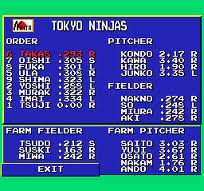
As we march through video game history, new concepts begin to emerge. The last entry we created a section for the scoreboard now we have enough history to compare and contrast the menu system within the baseball games. The menu system includes the process to pitch hit, modify lineup and or roster. The menu system in this game is very easy to navigate. As typical from previous games, the background for the roster management is solid blue with white text.
Sounds
The melody and background music is really nice and catchy. When there is a runner in scoring position the music’s tempo picks up a little bit. The melody between innings was also pleasant. The umpires voices were not very impressive and sounded muffled.
Gameplay
Modes

Three standard modes and one new mode for baseball video games are included in this game
- Versus Mode – 2 player single game
- Open Mode – 1 player single game
- Pennant Mode – 1 player tournament mode where at the end you play against the Turbo Tigers for the championship
- Edit Mode – This mode enabled the player to edit the team’s roster before you play. This is a great innovative mode and a great stepping stone for baseball video games. For the first time we can manage teams and not only the lineup but the general team roster including numerous players from the farm team/minor league that you can bring up and put in the lineup or have them selectable to pitch hit. I found myself enjoying editing the teams trying to invoke some baseball strategy into the teams
Defense
When fielders picks up the ball, he cannot freely move only able to move in a set path to a base or throw the ball to one of the bases. If you select a base to throw to and there is a fielder along the path of the ball, they catch the ball which forces you to throw the ball again to reach the base you intended in the first place. The best example of this is when you spot a runner stealing 2nd base, as a catcher you attempt to throw to 2nd base but the pitcher is in the middle of the throw and intercepts the ball. I ended up having to make the throw and then move the pitcher out of the way. This is not natural and really hinders the gameplay. It is not a deal breaker and something if played long enough will become something you just know you have to do. I feel throwing the ball is a tad slow; I feel the runners can run faster than the throw which makes double plays a rare thing. The fielding overall is really bizarre. It seems like we are back in the late 70's where you are controlling fielders as a unit, Which sort of worked in the old days when the whole playing field was displayed at once but when a ball zips through the infield and in the outfield it is frustrating, at point you are moving the infield up but then switch to the outfield and move the players down. I had to mentally think that the fielder I am really should be controlling is the outfielder that isn't in view yet. I found myself focusing on the small picture in picture of the field more than the main camera to get an idea on where I need to move
Offense
I didn’t have many problems with the offensive side of the ball. The batting was nice and fluid. I felt I was able to move the batter where I wanted and make contact with the ball. I did however notice that controlling base runners is my weakest part of my game. When the bases are loaded chances are I will screw it up and get a runner caught in a run down. This is not a knock on the game but more on my inability to control 4 baseball players at the same time. The base running mechanic is the same as the 8-bit version of the sport. This is due to the system having the same number of buttons and options.
Rules of Baseball
This is truly a gem of a video game regarding the aspects of baseball. The ability to edit a roster as well as the lineup really puts you in control of your team. The teams and players are not licensed by MLB or any established league so there is no joy of playing as your favorite player. The players didn’t have numbers on the backs of the uniforms which I missed.
Video Game Innovations
- Edit Rosters, Minor league/farm system
- Top Down Perspective
- Lawnmower lines in field
- Empty seats in the crowd
- Ball enlarged as it approaches the camera
- Batter moving legs as moves around the batter's box
- View the batter approach home plate
- Picture in picture of the field includes the fielders and not just the diamond
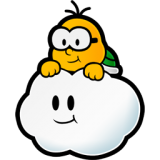
1 Comments